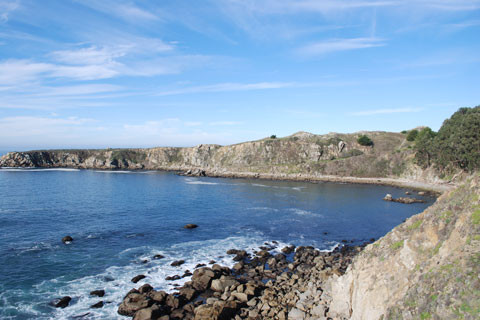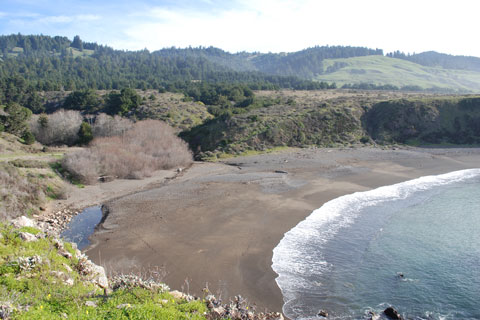Fort Ross State Historic Park Beaches
The two most popular beaches at Fort Ross are Sandy Cove Beach and North Cove Beach. The beaches are nice places to stroll and enjoy the scenery, but they are not safe for swimming or wading. No lifeguards are on duty.
Sandy Cove is almost directly below the fort. The beach is a pleasant place for a picnic. North Cove Beach is a mixture of rock and sand. Both beaches have small tide pool areas available for viewing when tides are low. Visitors should always keep a lookout for unexpected, large waves. Another rocky beach is located near the old Reef Campground (which has been closed).
The main attraction of the beaches and coast at Fort Ross are their historical sites both along the shore and underwater.

Fort Ross Underwater Park
The Underwater Park at Fort Ross extends around the Northwest Cape to Clam Beach and around the southern headland into the next cove. According to the State of California, the "underwater parks offer scenic diving and related activities, such as underwater photography and spear fishing. The parks are designed for divers and non-divers, with interpretation for both in visitor centers, kiosks and exhibit boards. In California, divers can dive anyplace you have legal access to the water."

Fort Ross Cove
S.S. Pomona Shipwreck
The steamship Pomona was a single-screw, steel-hulled passenger and freighter that ran between San Francisco and Vancouver. In 1908 during heavy seas the ship struck Monterey Rock and was so severely damaged that her captain attempted to ground the vessel at Fort Ross Cove. There the freighter struck rocks and was stranded. Much was salvaged from the ship before the wreckage was dynamited to remove it as a hazard.
SCUBA divers rediscovered the wreck in the late 1950s. The remains of the Pomona lie in waters from 27 to 40 feet deep, where divers can easily explore them.

Sandy Cove Beach
Historic Artifacts along the Coast
Around the South Cove are remnants of the early shipping that connected Fort Ross with Russia, Bodega Bay, and points south. At the North Cove are the remnants of iron pins where a lumber chute and wharf once stood in the late 19th and early 20th centuries. In the same area are fragments of light rail from a railway that once connected the surrounding cliffs with the wharf. All artifacts in the park, of course, are protected.

